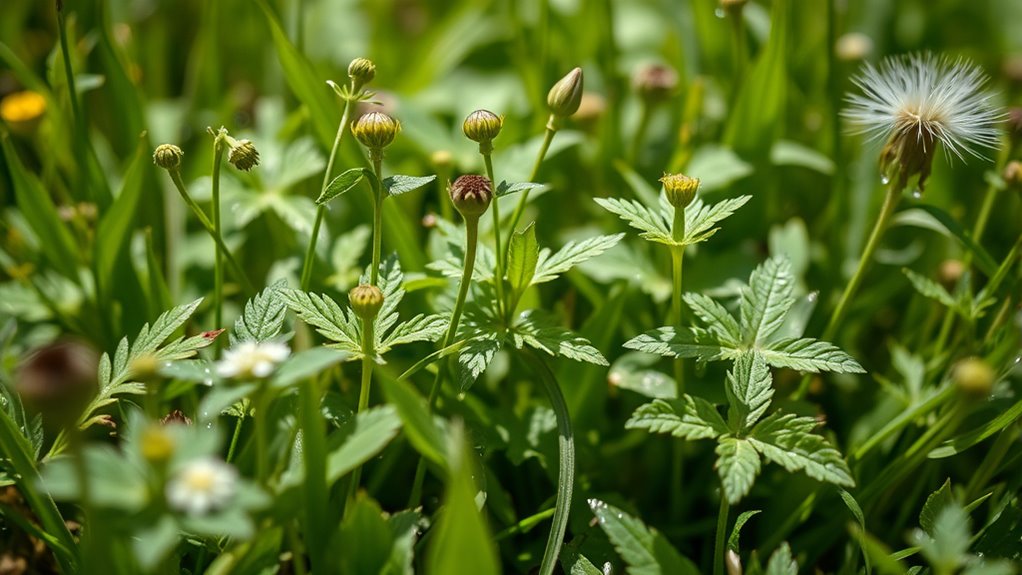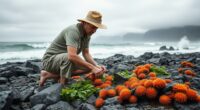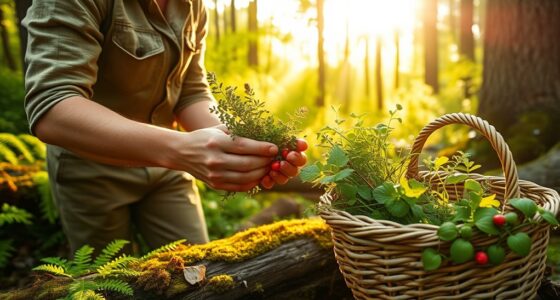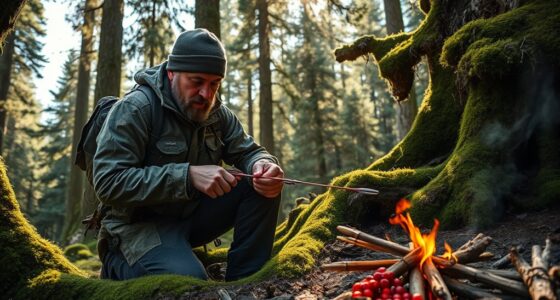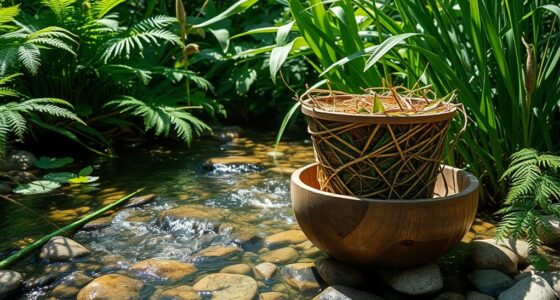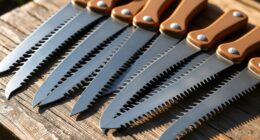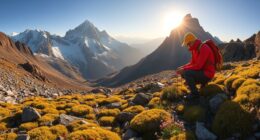For field first-aid, identify plants like aloe vera for burns, plantain leaves for cuts and bites, yarrow to help stop bleeding, and echinacea to prevent infection. Crush or apply these plants directly to the injured area, using healthy, fresh leaves when possible. Always verify plant identity and test for allergies before use. Keep exploring to learn more about safely using these natural remedies in emergencies.
Key Takeaways
- Identify plants like plantain, yarrow, and chickweed by their distinctive leaves and flowers to ensure safe use.
- Harvest healthy, mature plants in the morning using sharp tools and handle gently to preserve medicinal properties.
- Crush or steep plants such as plantain, yarrow, or echinacea to create poultices or infusions for cuts and stings.
- Apply aloe vera gel or crushed plantain leaves directly on wounds for soothing relief and infection prevention.
- Always verify plant identity, test for allergies, and avoid contaminated areas to ensure safe and effective field first aid.
Identifying Common Field Plants for First Aid

When you’re outdoors and need quick first aid, knowing how to identify common field plants can make a crucial difference. Accurate plant identification allows you to select the right herbal preparation to treat cuts, stings, or skin irritations effectively. Focus on key features such as leaf shape, color, and texture, as well as flower characteristics if present. Familiarize yourself with plants like plantain, which has broad, rounded leaves, and yarrow, recognized by its fern-like foliage and clusters of white flowers. Proper identification ensures you use safe, effective plants and avoid harmful look-alikes. Developing these skills enables you to harvest and prepare herbal remedies confidently, giving you a reliable first-aid resource right in nature’s midst.
Plant Preparation and Application Techniques

You need to know how to properly harvest and handle plants to keep their beneficial properties intact. Once prepared, applying the correct dosage is vital for safety and effectiveness. Paying attention to these techniques ensures you get the most out of your field first-aid plants. Additionally, understanding the importance of knowledge and learning can help you make informed decisions about plant use and safety.
Harvesting and Handling Methods
Proper harvesting and handling are essential to preserve the medicinal properties of field first-aid plants. When planning your plant harvesting, choose healthy, mature plants, and harvest at the right time—usually in the morning before the sun dries out active compounds. Use sharp tools to make clean cuts, minimizing damage to the plant. Handling techniques are equally important; handle plants gently to prevent bruising or contamination. Keep harvested plants in breathable containers, avoiding plastic bags that cause moisture buildup. Store them in a cool, dry place if you can’t process them immediately. Proper handling guarantees the potency of your plants remains intact, making your field first-aid preparations more effective when you need them most. Incorporating professional equipment can further ensure high-quality processing and preservation of your medicinal plants.
Applying and Dosage Guidelines
Once you’ve harvested your plants carefully, preparing them correctly guarantees their medicinal properties remain potent and effective. Accurate plant identification is vital to ensure you’re using the right species for cuts and stings. Follow dosage guidelines closely; applying too much can cause irritation, while too little may be ineffective. For topical applications, crush or grind fresh plant material into a poultice or infusion, then apply directly to the affected area. Use clean tools to prevent infection. When using dried plants, steep them in hot water to make a strong infusion or extract. Always test a small area first to check for sensitivities. Proper plant preparation and adherence to dosage guidelines are key to effective field first aid. Consistent application, within recommended dosages, maximizes healing while minimizing risks.
Aloe Vera: The Go-To for Burns and Skin Irritations

Aloe Vera is widely recognized as a natural remedy for burns and skin irritations due to its soothing and healing properties. To use it effectively, you need to identify the plant correctly—look for thick, fleshy, serrated leaves filled with clear gel. Proper plant identification guarantees you’re using the right plant and not a similar-looking species. When harvesting Aloe Vera, practice sustainable harvesting by taking only a few leaves from mature plants, allowing them to regenerate. This approach keeps the plant healthy and available for future use. Applying fresh Aloe Vera gel directly onto burns or irritated skin provides immediate relief, reduces inflammation, and promotes healing. Always wash your hands before handling the plant to avoid contamination. Additionally, understanding the best plants for first aid can help you be better prepared for minor injuries at home.
Plantain Leaves for Cuts and Insect Bites

Plantain leaves are another versatile remedy you can turn to for minor cuts and insect bites. These leaves contain compounds that help soothe inflammation, reduce swelling, and promote healing. To use, crush a fresh plantain leaf and apply the pulp directly to the affected area. The natural enzymes and tannins in plantain leaves form a protective barrier, easing pain and preventing infection. When dealing with insect bites, the anti-inflammatory properties help reduce itching and swelling quickly. Cover the leaf with a cloth or tape if needed, and leave it in place for several minutes. Plantain leaves are easy to identify and readily available in many outdoor areas, making them an essential natural first-aid resource for minor injuries and insect bites. Retail – Hours Today List can help you find nearby stores where you might access additional first-aid supplies if needed.
Yarrow: Nature’s Hemostat and Anti-Inflammatory

Have you ever needed a natural way to stop bleeding quickly? Yarrow is your go-to plant, known for its hemostatic and anti-inflammatory properties. When you identify yarrow in the wild, you can use its fresh leaves directly on cuts or brew herbal teas for internal inflammation. To recognize yarrow, look for feathery leaves and clusters of white or pink flowers. Applying crushed yarrow directly helps clot blood fast, while drinking yarrow tea supports healing from within. Keep a small bundle in your first-aid kit for emergencies. Understanding plant identification can enhance safe and effective use. Use the table below to help with plant identification and ideas for use:
| Identification | Use |
|---|---|
| Feathery leaves | Apply crushed for bleeding control |
| White/Pink flowers | Brew herbal teas for inflammation |
| Aromatic scent | Confirm plant, safe for topical use |
| Fresh leaves | Direct application or tea preparation |
Echinacea and Its Antiseptic Properties

Echinacea is renowned for its healing benefits and can help boost your immune response. Its antimicrobial effects make it a valuable natural remedy for infections. Understanding how Echinacea works can enhance your ability to use it effectively in first-aid situations.
Echinacea’s Healing Benefits
When it comes to natural remedies, Echinacea stands out for its powerful antiseptic properties that can help combat infections. Its healing benefits go beyond antisepsis, supporting your body’s immune response and speeding recovery. To harness these benefits, proper plant identification is key; look for its distinctive purple flowers and cone-shaped center. You can use herbal extraction methods, such as making tinctures or teas, to maximize its medicinal effects. Echinacea’s compounds promote tissue repair and reduce inflammation, aiding cuts and stings. Remember, harvesting at the right time guarantees potency. Incorporating proper harvesting techniques ensures you collect the most effective parts of the plant. Use Echinacea in your first-aid toolkit to accelerate healing and prevent complications. Its versatility makes it a reliable natural option for soothing and recovering from minor injuries effectively.
Antimicrobial Effects of Echinacea
Echinacea’s reputation as a natural remedy is largely due to its potent antimicrobial effects. When applied to cuts or stings, Echinacea antimicrobial properties help prevent infection by attacking bacteria and fungi. This plant also boosts your Echinacea immune response, speeding up healing. Visualize the plant’s vibrant purple petals and spiky center as symbols of its protective power. Its role in mental health emphasizes the importance of holistic approaches to healing.
Lavender and Its Soothing Effects on Stings

Lavender is renowned for its calming scent, but it also offers effective relief for insect stings. The lavender aroma contains compounds that help reduce itching, swelling, and pain. Applying a few drops of lavender oil, or a crushed lavender flower, can deliver quick comfort in field situations. Its soothing essential properties calm irritated skin and ease discomfort. You can use lavender in various ways:
- Dilute with a carrier oil before applying to skin
- Crush fresh lavender flowers for direct contact
- Use lavender-infused water as a compress
- Carry a small bottle of lavender essential oil
- Combine with other natural remedies for enhanced relief
- Safety measures should be followed to avoid skin irritation or allergic reactions.
Using Dandelion and Chickweed for Wound Care

Dandelion and chickweed are valuable plants to keep on hand for wound care in the field. Dandelion remedies are simple to prepare; you can crush fresh leaves to create a poultice that helps reduce inflammation and promote healing. Chickweed applications are equally effective—its soothing properties make it ideal for cuts and scrapes. To use chickweed, crush fresh leaves and apply directly to the wound, covering with a clean cloth or bandage. Both plants contain anti-inflammatory and antimicrobial compounds that speed up recovery and reduce infection risk. Additionally, understanding the safety considerations of using wild plants ensures proper and effective treatment. Keep a small bundle of dandelion and chickweed in your kit for quick access when injuries occur. These natural remedies are easy to identify and can be lifesavers when traditional first-aid supplies are unavailable.
Safety Tips and Precautions When Using Wild Plants

While wild plants can be valuable for first aid, it’s vital to exercise caution to avoid harmful effects. Always prioritize plant safety and follow foraging precautions to prevent poisoning or allergic reactions. Before using any plant, verify its identity with a reliable guide. Test a small skin patch to check for allergies. Avoid plants from contaminated areas, like roadsides or industrial sites. Never consume or apply wild plants unless you’re confident in their safety. Properly identify and prepare plants to reduce risks. Remember that some plants look similar but are toxic. When in doubt, consult an expert or avoid use altogether.
Always verify plant safety and avoid unknown or polluted areas before using wild plants for first aid.
- Confirm plant identification with trusted resources
- Test for allergic reactions before use
- Avoid plants near pollution sources
- Do not consume unknown plants
- Always follow foraging precautions
Frequently Asked Questions
How Do I Distinguish Edible From Toxic Plants in the Wild?
To distinguish edible from toxic plants in the wild, you use identification techniques like observing leaf shape, color, and growth patterns. Look for edible plant indicators such as certain leaf textures or smells that are familiar. Avoid plants with milky sap, hollow stems, or unusual odors. Always cross-reference with reliable guides or local expert knowledge, and never consume a plant unless you’re 100% sure it’s safe.
Can These Plants Be Used for Deep or Infected Wounds Safely?
Imagine trusting nature’s medicine—sounds appealing, right? But using plants for deep wound treatment or infected wounds can be risky. Many plants carry an infection risk, and improper use might worsen the situation. While some traditional remedies might seem helpful, they aren’t a safe substitute for professional medical care. Always prioritize cleaning, bandaging, and seeking expert help for deep or infected wounds, rather than relying solely on wild plants.
What Are Signs of Allergic Reactions to Wild Plant Remedies?
When using wild plant remedies, watch for signs of allergic reactions, like skin redness, swelling, itching, or hives. You might also experience difficulty breathing, dizziness, or nausea. To identify plant sensitivities, start with a small patch test before full use. If you notice any of these signs, stop applying immediately and seek medical help. Recognizing these symptoms early helps prevent serious complications.
How Long Should I Wait Before Applying a Plant-Based Remedy?
You should wait a few minutes after a cut or sting to observe for any allergic reactions or signs of worsening. The timing of application matters because you want to make certain the natural healing processes aren’t interrupted or worsened by applying a plant remedy too soon. If no adverse signs appear, gently apply the remedy, but always monitor the area closely, and seek medical help if symptoms worsen or don’t improve.
Are There Any Plants That Can Treat Multiple Types of Injuries?
Imagine holding a treasure chest of versatile healing herbs, each with the power to soothe more than one ailment. Some multi-purpose medicinal plants act like Swiss Army knives, offering relief for cuts, stings, and other injuries. These versatile healing herbs are invaluable in the wild, providing you with a natural toolkit that addresses multiple injuries at once, making your first aid kit both simpler and more effective in emergencies.
Conclusion
Next time you’re in the wild, picture a vibrant patch of plants ready at your fingertips—Aloe’s gel glistening like a soothing jewel, plantain leaves thick and cool as a gentle shield, yarrow’s delicate white blooms standing firm. With these natural remedies, you become your own first responder, turning nature’s gifts into healing touch. Trust what the land offers, and let it help you mend with the quiet strength of the earth beneath your feet.

